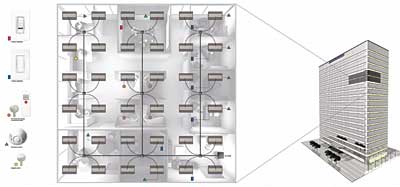The Essential Design Element for Any Office Space
|
Adaptable Lighting Control Systems
As office buildings mature the companies within them develop—departments are added and moved, floor plans are reconfigured, and neighboring structures are built that modify the daylight available to the office space. Traditionally, lighting control systems have been designed and installed to fit the existing office building layout. These lighting control systems could not adapt to the inevitable changes, and so offered limited long-term value to the building. In recent years, first-generation addressable dimming ballasts have solved flexibility issues, but they have been even more complicated to commission, and they have not adapted easily to daylighting. Additionally, when these ballasts fail they need to be re-commissioned. However, a new generation of lighting control systems is able to adapt, mirroring floor plan modifications and meeting evolving organizational needs efficiently.
The Technology
The technology and capabilities of this new generation is much more sophisticated, but the design is even simpler. The lighting system of entire floors—whole buildings—can be equipped to provide tuning, occupancy sensing, daylight harvesting, personal control and preset control with only a few key components. The fundamental components for a highly efficient and adaptable fluorescent lighting control system are:
- A new generation of multi-input addressable dimming ballast
- Simple, low-voltage sensors
- Occupancy sensors
- Daylight sensors
- IR receivers with remotes
- Wallstations
- A wireless handheld programmer
|
Multi-input addressable dimming ballasts replace non-dimming ballasts in fluorescent fixtures. From inside each fixture, these ballasts make it possible for the fluorescent lamp to dim. They are the energy-saving apparatus, tuning the fluorescent lamps to have a lower high-end light level. These addressable dimming ballasts also act as the communicative hubs for the entire fluorescent lighting control system. Incorporating intelligence into each fixture significantly increases the system’s flexibility. Fixtures can be addressed individually, or they can be grouped together, so multiple light fixtures respond to the same sensor—like communities within the larger lighting control system. Since each fixture containing an addressable dimming ballast can be controlled by itself or as a group, the fixtures can be readdressed as floor plans change.











